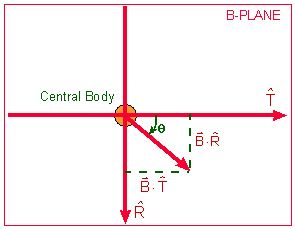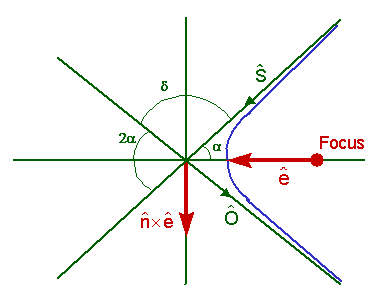B Plane Coordinate Type
The B-plane coordinate type is primarily used for hyperbolic arrival trajectories to specify the spacecraft’s state relative to the arrival central body. The initial state formulation uses the B-plane definition, which is a plane perpendicular to the incoming velocity asymptote direction. The B vector that lies in the plane gives the intersection of the incoming velocity asymptote with the B-plane. The B vector is typically defined in the context of two other vectors, R and T, that lie in the B-plane. The B-plane coordinates have four main parts:
- the incoming asymptote definition
- the B vector definition
- the orbital energy definition
- a time varying quantity
For more information about the details of the B-plane, see the technical note on B-plane targeting. An inertial coordinate system must be selected to use this coordinate type.
Incoming Asymptote Definition
Both of these values must be specified to define the incoming asymptote.
| Element | Description |
|---|---|
| Right Ascension of B-Plane Normal | The right ascension of the hyperbolic incoming asymptote in the selected coordinate system. Enter a value in the selected angle unit. Note that this value will be 180 degrees offset from the RA in the Target Vector Incoming Asymptote coordinate type. |
| Declination of B-Plane Normal | The declination of the hyperbolic incoming asymptote in the selected coordinate system. Enter a value in the selected angle unit. |
B Vector Definition
Two of the four elements below must be specified. B Magnitude can only be selected with B Theta in order to fully define the B vector.
| Element | Description |
|---|---|
| B dot R | The result of dotting the B vector with the R vector. Enter a value in the selected distance unit. |
| B dot T | The result of dotting the B vector with the T vector. Enter a value in the selected distance unit. |
| B Theta | The angle between the T vector and B vector. Enter a value in the selected angle unit. |
| B Magnitude | This length of the B vector. Enter a value |

In general, changing one of the six values specified on the initial state panel will not change any of the others disregarding numerical noise. There is some unique behavior if B Theta is selected for the first B vector definition parameter and either B dot R or B dot T are selected for the second B vector definition parameter. Both the value of B theta and the sign of B dot R and B dot T control the quadrant that the B vector is in. When one of the two values are changed in this configuration that it puts the B vector in a different quadrant inconsistent with the current definition, then the other value also changes.
For example, if B Theta is between 0 and 90 degrees and B dot T is selected with a positive value, then:
- Changing the value of B dot T to a negative value changes B Theta to be between 90 and 180 degrees consistent with the new value of B dot T and the old implicit value of B dot R (B dot R is kept constant).
- Changing the value of B Theta to be between 90 and 270 degrees changes B dot T to be a negative value consistent with the new value of B Theta and the old implicit value of B Magnitude (B Magnitude is kept constant).
Orbital Energy Definition
There are four options to specified the orbital energy. Only two (C3 and Semimajor axis) are available for closed orbits with eccentricity less than one. Additionally, when the eccentricity is less than 1, then the magnitude of the B vector cannot be greater than the value of the semimajor axis.
| Element | Description |
|---|---|
| Orbital C3 Energy | The characteristic energy for the orbit. Enter in the selected distance squared per time squared unit. |
| Semimajor Axes | Half the length of the major (longest) axis of the parabola or hyperbola. Enter in the selected distance units. |
| Hyperbolic V Infinity | The magnitude of the velocity infinitely far away from the central body. Enter in the selected velocity units. |
| Hyperbolic Turning Angle | The angle between the hyperbolic asymptotes, which is 180 degrees minus the angle between the incoming and outgoing asymptotes. See δ in the diagram below. Enter in the selected angle units. |

Time Varying Quantity Definition
There is only one option that must be specified for the time varying quantity. Note that
| Element | Description |
|---|---|
| True Anomaly | The angle from the eccentricity vector (points toward perigee) to the satellite’s position vector, measured in the direction of satellite motion in the orbit plane. There are restrictions on valid values for the true anomaly based on the eccentricity of the hyperbolic trajectory. Changes to other parts of the initial state may give errors if they cause the specified true anomaly to be outside the valid range for the new hyperbola. In these cases, first change the true anomaly to 0 before changing the other part of the initial state. Enter in the selected angle units. |